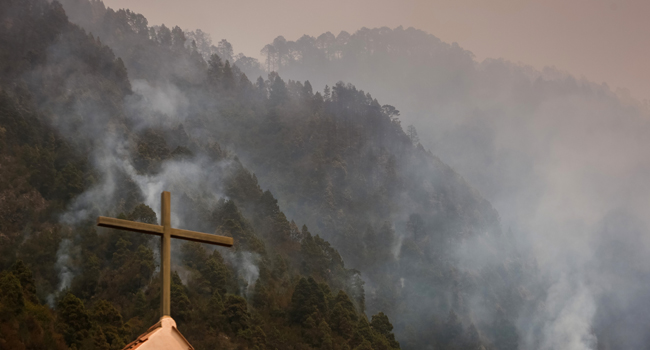An estimated 26,000 people may have been forced flee a wildfire raging out of control on the Spanish holiday island of Tenerife as high temperatures and strong winds plagued efforts to tackle the massive blaze, the emergency services said Saturday.
The huge blaze, which broke out late Tuesday in a mountainous northeastern area of the island, is the biggest fire ever experienced in the Canary Islands, officials said.
“Provisional estimates suggest that more than 26,000 people may have been evacuated,” the emergency services wrote on X, formerly known as Twitter, citing census data.
In an update late on Friday, officials said some 4,500 people had been evacuated since the fire began.
But following an unexpectedly difficult night of “severe weather” characterised by strong winds and higher-than-expected temperatures, the authorities ordered more evacuations.
“The fire and the weather have changed and we’ve had to evacuate five municipalities in northern Tenerife,” said Manuel Miranda, pointing to “the danger and the proximity of the fire”.
In an update around 1100 GMT, Montse Roman, technical director of the emergency, warned it was “possible that further evacuations may take place if the fire spreads”.
As the fire spread down the mountainside towards the northern town of La Matanza de Acentejo, Candelaria Bencomo Betancor, a farmer in her 70s, looked on in anguish.
“The fire is close to our farm, we’ve got trucks, vans, chickens, everything… it’s a business that is going well but if the fire comes, it will totally ruin us,” she told AFPTV, on the verge of tears.
“They have to do something because the fire is right there.”
So far the blaze has affected 11 municipalities on Tenerife, the largest of the seven Canary Islands. By late Friday it had burnt through 5,000 hectares (more than 12,300 acres), which is nearly 2.5 percent of Tenerife’s surface area which covers 203,400 hectares.
Canary Islands leader Fernando Clavijo said weather conditions overnight had been “severe… meaning the fire spread, mainly along the northern slopes”.
There had been “much stronger winds, temperatures much higher than expected and lower relative humidity”, he added.
‘A 6th-generation Wildfire’
Pedro Martinez, who is in charge of extinction efforts, told reporters the blaze was “behaving like a sixth-generation wildfire” — a term referring to a mega forest fire.
Its perimeter had “most certainly grown a lot” overnight and was “descending steadily” down the northern mountainside, he added.
“The fire is beyond our capacity to extinguish it, maybe not in all sectors, but in a large part of the sectors,” he admitted, as efforts to tackle the flames were being hampered by the huge clouds of smoke and the wind.
Maria del Pilar Rodriguez Padron, another resident of Matanza said she was sleeping in her car by the house.
“They offered us a place to stay but we prefer to stay in the car because we can watch the house and see whether it burns or not. Being elsewhere we just wouldn’t be able to sleep,” she told AFPTV.
Visiting the fire control centre and the affected areas, Interior Minister Fernando Grande-Marlaska said all the state’s resources were being made available to the island to tackle “this extremely serious emergency”.
Prime Minister Pedro Sanchez will also visit Tenerife on Monday.
Towering pillar of smoke
The blaze has generated a vast pillar of smoke that now stretches some eight kilometres into the air, officials said, rising far above the summit of Mount Teide, the volcano that towers over the island.
At 3,715 metres (12,200 feet), Teide is Spain’s highest peak and a popular tourist destination, but all roads to the national park were closed on Thursday.
The blaze broke out after the archipelago suffered a heatwave that left many areas tinder dry.
Last year was a particularly bad year for wildfires in Europe, with Spain the worst-hit nation, suffering nearly 500 blazes that destroyed more than 300,000 hectares, according to the European Forest Fire Information System (EFFIS).
So far this year, EFFIS says almost 76,000 hectares have been ravaged by 340 fires in Spain, one of the European countries most vulnerable to climate change.


